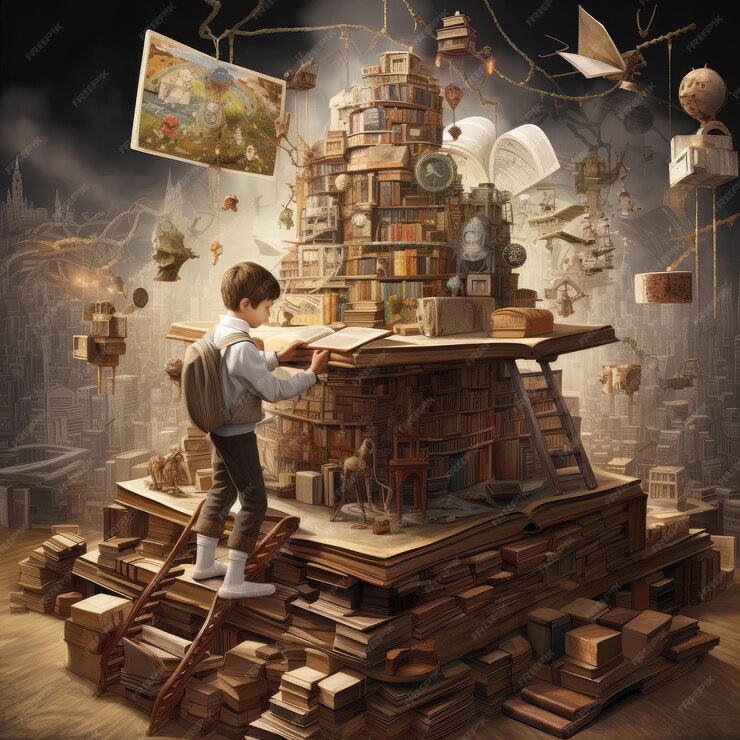The Beauty of Literacy

image source: Freepik.com
Exploring the Interconnection of Literacy and Literature: A Gateway to Cultural Understanding and Lifelong Learning
Literacy and literature are deeply intertwined, serving as both a catalyst for literacy development and a medium through which literacy skills are practiced and refined. Beginning with basic decoding and comprehension skills through the progression of a child’s development in fluency and vocabulary that culminates in higher-order skills such as analysis and critical thinking, students are exposed to a wide range of literary genres, styles, and formats that provide the raw material for literacy development.
Literature, spanning diverse cultures, social contexts, time periods, and perspectives, opens a gateway to cultural literacy. It equips students with a profound understanding of the human experience as they navigate through the rich tapestry of cultural symbols, values, and norms embedded in texts. This exposure allows readers to immerse themselves in the lives of characters from various backgrounds, enhancing their comprehension of human emotions and emotional intelligence. Literature that stimulates visual literacy nurtures an appreciation for the eloquence of language through storytelling. By encountering literary works that evoke powerful emotions, imagery, and sensory experiences, students can cultivate an admiration for the artistry of the written word.
Literacy skills enable students to engage more fully with literature. In turn, it can lead to a reciprocal relationship that enriches their literary understanding while fostering a lifelong love of reading and learning.
The Future of Literacy Studies Essay
The future of literacy studies is strongly tied to the analysis of decades, even centuries, of experiential literacy learning across the globe. John Dewey once said, “We do not learn from experience. We learn from reflecting on experience” (Dewey 78). By thoughtfully contemplating the literacy experiences of children, parents, families, cultures, and communities across the globe over time, we glean essential insights into the meaningful learning connections a person acquires from those experiences. Throughout this course, authors have endeavored to bring into focus what the future of literacy must become by careful consideration of how it is acquired–through observation and analysis. Peter Goggin examines the complexity of defining literacy in his Symbols and Earliest Writing video (Goggin) as he reflects on the “considerable multiplicities” of language’s social and cultural concepts throughout the ages. Nevertheless, it is through the passionate inquiry of those multiplicities that have helped bring us to an understanding of how oral communication, body language, and symbolism morphed into written language. The evidence of the actual acquisition of literacy is in people’s experiences, wherever those experiences occur–in our own nation or transnationally, in a small societal environment, or globally online.
In her narrative, Nerma Cockrell presented her local cultural experiences in literacy learning. Growing up in rural Mississippi during the crux of the 1960s civil rights movement, she discussed how strong the connection was between her church, her home, and the community as they were “integral parts of each other” in terms of literacy acquisition (Cockrell 0:43). Especially throughout her early life, the church heavily influenced her upbringing, specifically regarding literacy learning through her Sunday School experiences of memorizing Bible verses and learning to read Bible stories. There were no community recreation centers or other places for children’s activities: “The church was the hub of whatever it was that we did; it wasn’t the school, it was the church” (01:13). Cockrell explained that both her parents received only an eighth-grade education because the schools were poor; however, she remembers the family’s efforts to enhance their literacy acquisition by reading the catalogs they got from Sears & Roebucks and Montgomery Ward stores. Nerma Cockrell’s experiential literacy learning reminds me of what Gee said about small cultures functioning as a “society of intimates” (1989). Since then, the term “society of intimates” has changed in meaning, and the transnationalism of our global society has taken a prominent position in the study of 21st-century literacy.
Experiential literacy learning is still in action in today’s society, even though the face of it has changed. Like Nerma Cockrell’s small, rural society helped to process her literacy learning, the availability of global online literacy learning practices is equally a social process of experiences. In his article about the prospects of digital literacies, Warschauer (2009) reviews the international experiences of those participating in the new online forms of social interaction. Warschauer emphasizes that while these digital practices of literacy engagement do not replace, but instead enhance, the “underrecognized literary practices” that take place in non-school environments in the home or the community. He calls these types of literacy practices “invisible” and states, “The historical traditions of Literacy Studies, which include an attention to diverse semiotic resources, a focus on social interaction, and a commitment to exploring non-dominant discourses, have led to groundbreaking research on the invisible forms of literacy that occur in digital domains.” Warschauer stresses the need for educational institutions to take a good look into the experiences of those “invisible” global literacy learning practices to ameliorate outdated practices in 21st-century classrooms.
Lam & Warriner (2012) further study global literary experiences, discussing the value of literacy practices that serve as “cultural capital” in social exchanges. It is the experiences of migrants in transnationalism versus basic assimilation that connect literary techniques across the realm of discourse. Again, as with Cockrell, Lee & Warriner reflect on how “narratives and other discourse practices” within the family and their ties to their cultures help them transition into new social fields. Migrants often incorporate those family experiences into their new environment “…to construct a new critical and transnational perspective that informs their literary practices” (200). These types of transnational literacy experiences of family and cultural identity inform researchers on promoting better engagement of academic literacy practices in the local education arena. Studying all these types of experiential learning leads to the next step of best practices in the future of literary studies, “Constructing a shared concern and site of knowledge building,” (Clifton 2017).
Jennifer Clifton leads decades of literacy studies toward changing our nation’s English Language Arts classes from simply studying grammar, with all of its pieces and parts, into “Creating contexts of discovery for cultivating deliberative publics…[and] engaging youth in attending to lives–theirs and others,” (75). It stresses the importance of helping students learn to participate in forming new concepts for achieving argumentative social practices that are inclusive of the needs of those with little or no voice in today’s societal discourse. Again, experiential learning is a way to reach this goal. Since our students will be the next generation of nation-leading adults, they must learn to share ideas cooperatively, listen to other’s perspectives, and strive to assist in altering the way they think and the thinking of others. Clifton shares the experiences of a teacher who engaged students in a discussion of dialogue across differences where even he, the teacher, found it difficult to see some of his students’ arguments with an open mind. Transforming people’s biases, stereotypes, and opposing perspectives is not an easy task. Clifton explains how using an open, honest conversation with others in ways that will not just reinforce “the status quo or power differentials or staunch positions” (8) is a way to begin the new theory of literacy learning through arguments about public life, and she stresses that dialogue must be multi-voiced and continual if society creates positive outcomes focusing on each other’s well-being.
The inquiry into the literacy experiences of the human race over time and space supports the new literacy learning theory. Man’s humble local literacy beginnings have become a global literacy field. It is face-to-face, culture-to-culture, and nation-to-nation, both in person and through technology. Bringing beneficial discussion that culminates in meeting the people’s needs, hopes, and desires through experiential public literacy action is definitely a complex and arduous task; however, it is an essential task if our society is going to progress in its mission toward unity and equity.
Works Cited
Clifton, Jennifer. Argument as Dialogue Across Difference: Engaging Youth in Public Literacies. New York, Routledge, 2017. Accessed 23 April 2023.
Cockrell, Nerma. “Literacy Learning in Rural Mississippi.” Digital Archive of Literacy Narratives, 25 October 2011, https://www.thedaln.org/#/detail/6464c9e9-89e5-422a-8d5f-8830d805cef5. Accessed 25 April 2023.
Dewey, John. How We Think: A Restatement of the Relation of Reflective Thinking to the Educative Process. Boston, Heath & Co Publishers, 1933.
Gee, James Paul. “Literacy, Discourse, and Linguistics.” Journal of Education, 171(1):1989.
Goggin, Peter. Symbols and Earliest Writing. Video Lecture: Defining Literacy. Oxfordshire, Uffington White Horse.
Lam, W. S. E., & Warriner, D. S. (2012). “Transnationalism and Literacy: Investigating the mobility of people, languages, texts, and practices in contexts of migration.” Reading Research Quarterly, 47(2), 191-215.
Warschauer, Mark (2009). “Digital Literacy Studies: Progress and Prospects,” 123-140.

